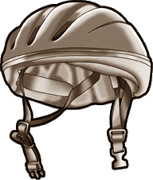 Wearing helmet when riding a bike should never be taken for granted. Crashing is inevitable even when riding in a low-speed, and it can happen even to the most careful rider. The impact of a crash regardless of speed is equally damaging to the head of any person. This can be the reason why in the twenty-two states in the U.S., there is a law requiring the wearing of helmet. In buying bicycle helmet especially kids helmets, there are things to consider in order to have the most appropriate one for the purpose.
Wearing helmet when riding a bike should never be taken for granted. Crashing is inevitable even when riding in a low-speed, and it can happen even to the most careful rider. The impact of a crash regardless of speed is equally damaging to the head of any person. This can be the reason why in the twenty-two states in the U.S., there is a law requiring the wearing of helmet. In buying bicycle helmet especially kids helmets, there are things to consider in order to have the most appropriate one for the purpose.
The Component of Bicycle Helmet
When a bicycle rider crashes, the helmet can reduce the effect of sharp impact. This is because the helmet is designed with the purpose of protecting the rider. The following is the basic components of helmet:
➢ Shell:
Bicycle helmets have plastic shell covering for the purposes of holding the helmet together during a crash. It is puncture-resistant and slides conveniently upon impact.
➢ Liner:
The liner is made of crushable expanded polystyrene foam. The liner is capable to dissipate the momentum of the impact to protect the head of the rider.
➢ Straps and Buckle:
The straps and buckle are responsible for the helmet to stay in place even during the toughest ride. It can be adjusted to make the helmet fit well.
➢ Ventilation:
The ventilation is useful for the airflow of the helmet that keeps the head cooler and comfortable.
What to Look for When Buying Bicycle Helmet
There are at least three types of bicycle helmet, road, mountain, and sport bike helmets. All of these helmets are designed to provide protection for bicycle riders. An essential feature of a good helmet is the fit. Take a measurement of the head before shopping in order to get the right fitting. The stores have the available sizes categorized by their respective measurement. Kids helmets usually come in one size.
When buying a helmet, make sure that it has the Consumer Product Safety Commission Safety (CPSC) sticker. Fit the helmet in the head to make sure that it matches the specified size. Well-fitted helmet must be snug and sit leveled on the head. Adjust straps and buckles then test if it holds very well. It is also equally important to check the ventilation and the inner foam lining to ensure that the helmet is comfortable.
Helmet Replacement
Whenever a bicycle rider was involved in a crashed, the helmet is most likely to be damaged. For safety purposes, it is advisable to replace the helmet even if damage is not evident. Regular exposure to ultra violent light, pollution and weathering contribute to the normal wear and tear of the helmet. In general, it is recommended that helmet should be replaced after five years.
Before using a helmet, it is helpful to read and understand the owner’s manual. When cleaning the helmet, do not use solvents or chemicals in order to maintain its durability. Never store helmet where there is excessive heat. The lifespan of the helmet is dependent on how it is maintained.
